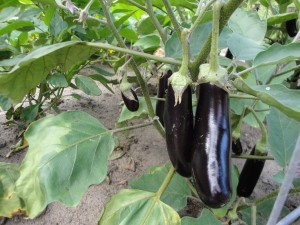Is It Ripe Yet?
Knowing when to pick vegetables for peak taste and texture is a skill many gardeners develop after years of trial and error. Generally, however, vegetables fall into two categories.
 Pick-early, pick-often. Some vegetables deteriorate noticeably if they are left in the garden too long. For these veggies, the best bet is to pick them young and succulent. For example, most snap beans should be picked at the width of a pencil or thinner. If you see bumps from seeds on the bean pod, it has probably gone too long. Later in the summer, leave some of those pods on the vine until frost and save the seed for next year.
Pick-early, pick-often. Some vegetables deteriorate noticeably if they are left in the garden too long. For these veggies, the best bet is to pick them young and succulent. For example, most snap beans should be picked at the width of a pencil or thinner. If you see bumps from seeds on the bean pod, it has probably gone too long. Later in the summer, leave some of those pods on the vine until frost and save the seed for next year.
Cucumbers also need regular picking so they do not get big and seedy. Harvest them depending on your planned use. For pickles, about 4 inches long is a good length. If you plan to eat them fresh, let them get bigger. The early-and-often rule also applies to summer squash and, of course, zucchini. No one wants to eat a squash the size of a baseball bat. Check them everyday or at the most every other day to avoid zucchini monsters.
Other vegetables that taste better after an early harvest are broccoli (the flower buds should be closed), eggplant, most greens (start harvesting when the leaves are 4 inches tall on the outside), and radishes.
Wait for it. Some vegetables give more clear indications of when they are ready to harvest. With onions, for example, the tops will fall over, letting the gardener know it is time to dig. Most guides recommend that new potatoes be harvested when the plants flower, but for mature spuds wait until the plant turns brown. Melons tend to fall right off the vine when ripe, and you want to catch them just before that moment. Muskmelons give off a rich aroma that says, “I’m ripe.”
Color and feel should be your guide for tomatoes. You want them to reach the correct color for the variety you’ve planted and be slightly soft. Generally, ripe tomatoes come off the vine with barely a tug.
Root vegetables, such as beets, carrots and parsnips, can be harvested at whatever size you like. And, parsnips and carrots often develop a sweeter flavor if left in the ground after a frost.
Winter squash needs to stay on the vine so it can reach its full color and have a skin that is so tough that it is difficult to puncture with your fingernail. Only then, should the squash be cut from the vine (with a stem on it) and allowed to mature in a cool, dry place.
